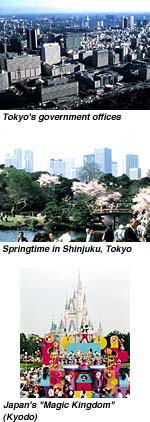
 |
 |

-
Tokyo: The Nation's Political, Economic, and Cultural Hub Tokyo served as Japan's political center from the beginning of the seventeenth century to the middle of the nineteenth, when the nation was ruled by the Tokugawa shogunate. Known in this time as Edo, its population reached some 1 million. That's more than lived in the great metropolises of London or Paris.
In 1868 the city became the nation's capital when the Emperor moved from Kyoto to Edo, which was renamed Tokyo. Thereafter, Tokyo became a globally important city, not only Japan's political center but also the hub of the economic, cultural, and all other national functions. In 1964 it became the first city in Asia to host the Olympic Games.
Tokyo covers a land area of 2,050 square kilometers (790 square miles) and is home to 12 million people. The Imperial Palace, National Diet, Supreme Court, and central bureaucracies are all in Tokyo, which is also where the financial and largest commercial districts are concentrated.
There are hundreds of cultural facilities. At its theaters and history and art museums, widely talked-about events and exhibits are staged nearly every day. And its many universities draw young people from all over Japan. With up to 270,000 foreign residents, it is quite an international place.
Tokyo has many faces. The Harajuku area is the national fashion center with rows of brand-name boutiques as well as stalls offering casual wear; Ginza is a ritzy shopping zone with many luxury and long-established stores; Akihabara is an electronics bazaar; western Shinjuku is an island of skyscrapers; and Asakusa retains the feel of a traditional Japanese downtown area. Just east of the metropolis is Asia's only Disneyland, attracting visitors from throughout Japan as well as from Southeast Asia.

RETURN TO
QUESTION
LOOK AT ANSWER